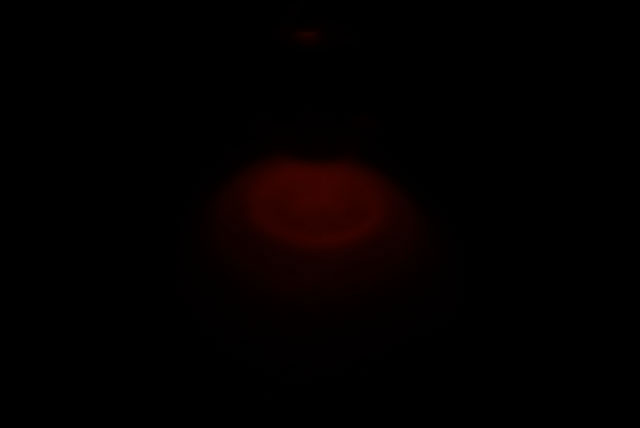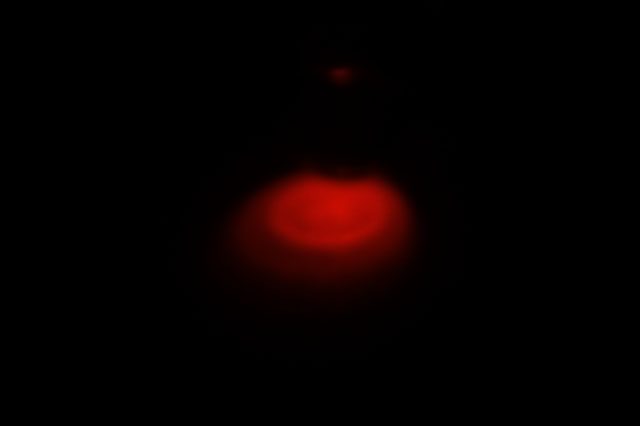

Unmodified Canon 350XT response to 660 nM light at 1/160th second exposure
Same camera after modification with Baader UV/IR Block Filter
Comparison of Hydrogen-Alpha
Sensitivity in Modified vs Stock Canon DSLR's
The "LED Nebula"...
 |

|
|
Unmodified Canon 350XT response to 660 nM light at 1/160th second exposure |
Same camera after modification with Baader UV/IR Block Filter |
While stock DSLR's are fine for capturing galaxies, reflection nebulae and star clusters, they are woefully lacking in sensitivity to hydrogen-alpha energy. This is the light from glowing hydrogen that gives emission nebulae their characteristic red color. However, that sensitivity is already built into your camera...you only need to release it. All digital cameras have a filter in front of the imaging chip which greatly attenuates infrared energy which skews the natural visual color balance and does not focus at the same point as visible light...and DSLR's are no different. Unfortunately, the camera manufacturers didn't have astronomy in mind when they designed these filters since they greatly attenuate hydrogen-alpha light which falls in the spectrum between deep red visible light and infrared. In the Canon DSLR's, the response to hydrogen-alpha is down to about 20% of the sensitivity to other colors. This causes astronomical photographs of emission nebulae to appear washed out. As in the picture from the unmodified camera to the left above, the object of interest may be almost completely absent! Unfortunately, it is very difficult to make up the difference by simply exposing longer or stacking more images since the signal-to-noise ratio at the critical hydrogen-alpha wavelength is so low. The solution is to remove the camera's IR filter and either leave it out, or replace it with another filter that blocks the long-wave IR energy but passes hydrogen-alpha. In recent discussions with Michael Covington ("Astrophotography for the Amateur") about measuring the actual increase in performance brought about by the camera modifications I offer, he suggested using a commercially available special LED designed to produce a spectral peak output at 660 nM, which is very close to the wavelength of hydrogen-alpha emissions at 656.3 nM. The LED would be photographed with the same camera at a number of exposure times both before and after modification and the peak illuminations measured. I obtained several of the LED's and set out to test a Canon 350XT pre and post modification. The results were stunning, to say the least, but not unexpected since I have been shooting with modified cameras for the past three years and know well the performance increase gained by the modifications. You can see some of my photographs from modified cameras HERE. The setup consisted of wiring one of the 660 nM LED's in a series circuit with a variable voltage power supply, a 1000 ohm resistor, and a digital ammeter to monitor the current through the LED. The goal was to operate the LED at about 10% of its rated current so the LED would be dim and more spectrally pure. The power supply was set to produce a current of 2.0 milliamps through the LED. The light output from the LED is in a fairly narrow beam, so it was decided to aim the LED at a white card and shoot the reflection so that the resulting illumination would not be as subject to slight camera angle changes during testing. The camera with a stock "kit" zoom lens was mounted on a tripod and operated with a remote shutter release. The ISO was set to 100, image type to RAW, the lens to f/ 5.6 and zoomed all the way in. A series of eight exposures from 1/60th second to 1/320th second were taken with the "LED Nebula" in the middle of the frame. The RAW frames were converted to 16-bit TIFF's in ImagesPlus 2.75 using Canon daylight white balance. The TIFF's were opened in Photoshop CS2 and the peak brightness in the red channel was found and measured. No other processing at all was done. After modification of the camera by removing its stock IR filter and replacing it with a Baader DSLR UV/IR filter from Alpine Astro, the series of test shots was repeated. The results are in the table below:
As can be seen, the exposure time to peak brightness in the stock camera is very linear as expected...a doubling of exposure time results in a doubling of the peak brightness showing no reciprocity failure over the range of exposure times used. At the four fastest exposures at the bottom of the chart, it is clear that the modification produces a gain of 3.4 times the sensitivity to the hydrogen-alpha wavelength. This gain causes the four longer exposures to go into saturation! The two photographs above show the results of the 1/160th second exposures before and after modification (crops of the center portions of the photographs). Quite a bit of difference! If you are interested in having me modify your Canon DSLR, please see my web site HERE.
BACK... |
||||||||||||||||||||||||||||||||||||||||||||||||||